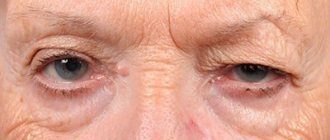Intellectual disabilities in children
The clinical picture of intellectual impairment is varied. Symptoms should be considered in accordance with the classification: with quantitative changes, there is a decrease in learning ability, difficulties/impossibility of self-care, with qualitative changes, a decrease in intelligence is combined with mosaic, partial development of individual functions.
Impaired mental function.
The level of intelligence is below average, reaching levels borderline with mental retardation. There are two variants of the clinical picture. If cognitive activity is impaired due to insufficient development of the emotional-volitional sphere, a lack of interest in cognitive activity comes to the fore: children are active, impulsive, and prefer simple games. They are not interested in creative and educational activities; they are difficult to organize and encourage reading and drawing. The second option is insufficient formation of the prerequisites for intelligence (memory, performance, attention). Children lack initiative, are not independent, are overly active or passive, get tired quickly, work at a slow pace (signs of cerebrovascular disease).
Moronism.
It is characterized by the primitiveness of thinking, its attachment to specific, visual situations, insufficient differentiation of emotions, and weakness of volitional impulses. Patients later master self-care skills, are able to dress independently, and perform hygiene procedures. According to a special curriculum, they master writing, reading, and counting. Teenagers learn simple working professions.
Imbecility.
Thinking is slow, stiff, experience is difficult to adopt. Intellectual-mnestic functions are reduced. Social interaction is limited and learning skills are impossible. Children are delayed in mastering self-care and simple homework.
Idiocy.
Characterized by a lack of speech and the ability to establish productive contact with others (with the exception of single executions of simple commands). There are often concomitant neurological pathologies and diseases of internal organs. Mobility is limited and self-care is not available.
Damaged and deficient development.
The unevenness of intellectual impairments is explained by the mosaic nature of the damage to the central nervous system: some functions are developed and continue to develop at a normal pace, others slow down (depending on the location of the damage - speech, spatial, auditory-verbal perception, memorization). Complex hierarchical connections fall apart, and intellectual retardation develops. Deficient development leads to intellectual impairment based on a primary defect - pathology of the analyzer (hearing, vision), motor system.
Distorted and disharmonious development
. It is caused by an ongoing pathological process that disrupts the uniform development of functions. Children have well-developed verbal intellectual functions, but adaptation is complicated by the difficulty of assimilation and understanding of social rules. Or the child has unique mathematical abilities, but everyday skills are difficult.
Types of impairments “Intellectual impairments”
Intellectual impairment
Etiology and pathogenesis of oligophrenia
Oligophrenia (from the Greek oligos - baby, phren - mind) is a special form of mental underdevelopment, expressed in a persistent decrease in cognitive activity in children due to physical damage to the cerebral cortex in the perinatal (intrauterine) and early postnatal (up to 2-3 years) periods. Signs of oligophrenia are:
1) durability;
2) irreversibility;
3) organic origin of the defect;
4) non-progressive (not progressive in nature).
The pathogenesis of various forms of oligophrenia is not the same, but there are also common mechanisms.
An important role is played by the course of the period of ontogenesis, during which the developing brain of the child is damaged.
Various pathogenic factors, both endogenous, exogenous, and mixed, can cause changes in the brain, which are characterized by similar clinical manifestations of the disease.
One of the main causes of oligophrenia is the time of exposure to the pathogenic factor, its localization, the extent of the lesion and the body’s resistance. Etiological factors of oligophrenia:
1) endogenous (hereditary);
2) exogenous (exposure to various chemicals, radiation, etc.)
3) mixed nature of oligophrenia.
Clinical forms of oligophrenia, established based on etiology
Group I
Oligophrenia caused by hereditary factors
Microcephaly.
Microcephaly can be true or false. True (primary), hereditary microcephaly is quite rare.
In addition to the small size of the skull, there are disproportions between a small skull and normal growth, a sharp underdevelopment of the cerebral part of the skull compared to the facial part, a low sloping forehead, excessive development of the brow ridges, and an elongated head shape.
Intellectual deficiency usually corresponds to idiocy or deep imbecility. Despite significant dementia, there is emotional liveliness, increased irritability and suggestibility. Microcephalics are emotionally unstable and prone to the affect of anger.
False (secondary), cerebropathic, microcephaly is caused by intrauterine damage to the embryo. Along with signs of underdevelopment, focal neurological symptoms and seizures are common; the deformation of the skull is more severe than with true microcephaly and is combined with a dysplastic physique; severe retardation in height and body weight.
Dementia is more severe, patients are apathetic, gloomy, lethargic. However, it is not possible to draw a clear line between true and false microcephaly.
Xerodermic form (Rad syndrome)
- a rare anomaly, a combination of ichthyosis with mental retardation. Inherited in a recessive manner. The skin is covered with easily removable dry scales, reminiscent of fish scales. In severe forms of ichthyosis, children die quickly. Mental underdevelopment is often accompanied by convulsive seizures.
Diseases caused by disorders
metabolism
Phenylketonuria (phenylpyruvic oligophrenia)
associated with impaired phenylalanine metabolism; is inherited in a recessive manner. Dementia is combined with depigmentation (from albinism to light hair and iris) and in approximately 30% of cases with seizures. The brain part of the skull is poorly developed. There is an awkward gait, poor coordination of movements, many stereotypical actions, and hyperkinesis. Muscle tone is changed.
Dementia is pronounced. It seems possible to detect signs of mental underdevelopment even in infancy. Throughout the first year of a child’s life, a tendency towards progression of dementia is observed; after 3-7 years the condition stabilizes.
Homodistainuria is associated with a disorder of methionine metabolism, is inherited in a recessive manner, and is manifested by cramps, muscle weakness, and sometimes increased readiness for muscle spasms. There is a delay in psychomotor development. Changes in the eyes are observed. These include cataracts, retinal degeneration, ectopic lens, etc. The skin around the eyes is red.
Galactosemia, fructosuria, sucrose are inherited in a recessive manner. Children experience malnutrition, diarrhea and other severe somatic disorders that lead to death. Mental underdevelopment is strongly expressed, accompanied by lethargy and convulsions.
Morphan syndrome
- a disease caused by a violation of polysaccharide metabolism. This hereditary disease is based on systemic damage to connective tissue. This disease occurs equally in both men and women. Symptoms appear from birth. These include:
1) anomalies of eye development;
2) developmental anomalies of the musculoskeletal system;
3) developmental anomalies of the cardiovascular system.
With this disease, not all children have an intellectual defect. For many, mental development corresponds to the age norm.
Gargoilism
- a hereditary disease caused by metabolic disorders involved in the formation of connective tissue. This disease occurs more often in men than in women. Clinical manifestations become noticeable in the first month of a child’s life. These include an increase in the size of the skull, deformation of the ears, deformation of the chest, thick short fingers, wide palms, and joints are affected. Mental development is sharply delayed, the intellectual deficit increases over time, and quite often the intellectual development defect reaches the level of idiocy.
Lawrence syndrome
- oligophrenia associated with dysfunction of the hypothalamus. With this disease, signs of disorders of fat and protein metabolism appear. Autonomic and endocrine changes appear. Mental defect ranges from mild mental retardation to idiocy.
Oligophrenia caused by chromosomal aberrations
Down's disease
caused by chromosomal abnormalities, associated with an extra 21st chromosome.
The incidence of this disease ranges from 1:600 to 1:900. Children who have this disease are small in stature, short limbs, short fingers, a small skull with a flattened bridge of the nose, and a high palate. Teeth grow incorrectly and are often affected by caries. There is underdevelopment of the upper jaw, the lower jaw protrudes. The tongue is thick. The ears are small, the hair on the head is sparse, the skin is dry. The genitals are underdeveloped. Often these signs are combined with heart defects and muscle hypotension. The face is inexpressive, the mouth is half open. Mental retardation reaches debility in 5% of cases, imbecility in 75% of cases, and idiocy in 20% of cases. Patients are characterized by increased suggestibility.
Shereshevsky-Turner syndrome
observed only in females. Caused by the lack of one X chromosome. Sex chromatin is absent. Patients are characterized by sexual infantilism, various dysplasias, short stature, and deformed and low-set ears. Malformations of the cardiovascular system are common. Mental retardation comes in varying degrees, often mild.
Klinefelter's syndrome
typical only for males. Increase in the total number of chromosomes. Primary and secondary sexual characteristics are weakly expressed. Patients are tall. Often infertile. Oligophrenia within the range of mild debility.
The first group also includes oligophrenia associated with damage to the generative cells of parents due to exposure to chemicals, ionizing radiation, increased dust, etc.
Group II oligophrenia
This group includes diseases caused by damage to the embryo and fetus. The causes of developmental disorders of the embryo may be different.
Oligophrenia of infectious origin
(rubella, influenza, parainfluenza, etc.). Damage to the embryo is directly related to the timing of pregnancy (often at 5-9 weeks). Dementia is combined with developmental defects of the eyes, hearing aid, and developmental defects of the cardiovascular system. Skeletal malformations, dental defects, and general physical underdevelopment are common. Mental underdevelopment is usually to the extent of idiocy.
Congenital syphilis.
Signs of dementia appear early. There are oligophrenias of various degrees. In addition to mental underdevelopment, psychopathic, asthenic syndromes are observed. Manifestations of epilepsy are possible. Common physical defects are characteristic.
Toxoplasmosis.
The child has a deformation of the skull, abnormal bone structure, and malformations of internal organs. The brain and eyes are mainly affected. Epilepsy often develops. Mental underdevelopment to the extent of imbecility, idiocy.
Listeriosis.
The occurrence of the disease is associated with internal damage to the fetus from a sick mother. Mental underdevelopment - to the extent of idiocy.
Other infections affecting the embryo can also lead to the development of oligophrenia; hormonal disorders, as well as other endogenous and exogenous toxic factors
Cretinism or hypothyroid oligophrenia
- the most common of all forms of dementia, which occurs as a result of endocrine disorders.
Congenital hypothyroidism is distinguished due to insufficient iodine content in drinking water.
Another form of hypothyroidism is sporadic cretinism.
It can be observed in any area. Caused by a hereditary defect in the synthesis of the hormone produced by the thyroid gland. The degree of manifestation of cretinism depends on the lack of thyroidin. Mental underdevelopment manifests itself from the degree of debility to idiocy.
III group
Oligophrenia that developed as a result of exposure to harmful factors of the perinatal period and the first 3 years of extrauterine life
Hemolytic disease.
If the fetus and mother are incompatible according to the Rh factor or blood groups, the newborn develops hemolytic disease.
The leading clinical symptom of hemolytic disease of the newborn is jaundice, which occurs in the first 36 hours of life. Jaundice increases over the next 2-3 days. Children become lethargic, drowsy, stop sucking, develop oculomotor disorders, convulsions, and muscle hypotonia. Unconditioned reflexes are sharply depressed, the liver and spleen are enlarged. In the absence of timely therapeutic measures, focal neurological disorders appear: muscular dystonia, hyperkinesis, strabismus, hearing loss, and delayed mental and motor development are characteristic. This type of mental retardation is characterized by a mild or moderate intellectual defect; profound dementia rarely develops.
Atypical oligophrenia.
Oligophrenia caused by hydrocephalus is observed only with severe hydrocephalus. Dementia ranges from mild debility to idiocy. Speech is much better developed than thinking. Oligophrenics may have a good ear for music and the ability to perform mental calculations. They are complacent, talkative, euphoric, only some of them are irritable, gloomy, and prone to affective outbursts. They often experience seizures. The physical signs of severe congenital hydrocephalus are very typical: a large skull with a convex forehead and flattened orbits, a triangular face - small in comparison with the large skull. The fontanelles do not heal for a long time and bulge greatly. Almost all patients experience certain motor disorders (paresis, paralysis of the limbs), atrophy of the optic nerve, damage to the hearing and vestibular apparatus.
Craniostenosis develops due to early fusion of cranial sutures. Because of this, the skull is deformed and one or more sutures may be missing. In such children, intracranial pressure increases, visual acuity decreases, vomiting, and headache occur. Mental retardation varies in degree of manifestation.
Mental retardation combined with cerebral palsy. This oligophrenia is observed in approximately 60% of cases of this disease. It is expressed to varying degrees and is characterized by unevenness and a complex structure. The group of syndromes is a consequence of brain damage that occurred in the prenatal, intrapartum (during childbirth) and early postnatal periods. A characteristic feature of cerebral palsy is a violation of the child’s motor development, caused primarily by the abnormal distribution of muscle tone and impaired coordination of movements. There is a delay in speech development. Dysarthria is often observed in cerebral palsy. The degree of mental disorders ranges from mild disturbances in the emotional-volitional sphere to severe intellectual defects.
Oligophrenia caused by fetal asphyxia.
Asphyxia at birth is observed in 4-6% of newborns and is one of the causes of perinatal mortality.
Oxygen deficiency leads to severe metabolic disorders in the body of the fetus and newborn. As a result, nerve cells are damaged. The degree of their damage depends on the severity and duration of intrauterine hypoxia and asphyxia at birth.
The mental defect ranges from mild debility to idiocy, combined with neurological symptoms.
Birth injury.
The occurrence is facilitated by various types of obstetric pathologies (rapid, protracted labor, narrow maternal pelvis), improper management of obstetric operations, and the application of forceps to the baby’s head.
Neurological symptoms are observed.
Oligophrenia resulting from a traumatic brain injury suffered in early childhood. There are no physical malformations or malformations of individual organs. There is a decrease in performance, a psychopath-like syndrome.
Mental underdevelopment is combined with symptoms of organic dementia.
Oligophrenia caused by early postnatal infections.
This type of infection includes various encephalitis (tick-borne, mosquito-borne, measles, chickenpox encephalitis), meningitis.
Mental underdevelopment is combined with symptoms of physical dementia.
Despite enormous advances in research into the etiology of mental retardation, in many cases it remains unknown. According to various sources, from 50% to 80% is so-called idiopathic oligophrenia.
General symptoms of oligophrenia. Mental processes in oligophrenia
With oligophrenia, the child’s mental development occurs on an inferior, defective basis, but there is no long-term course of the disease of the nervous system and the child is considered practically healthy.
The characteristics of the mental development of such children are similar in many aspects, since their brain is affected before the development of speech begins.
Children represent a homogeneous group from a psychological point of view, although they may differ in the etiology of the disease.
Most authors prove that the main defect observed in oligophrenia is the difficulty of generalization (M.S. Pevzner) or, in other words, the weakness of the regulatory role of speech.
G.E. Sukhareva identifies central defects. There are two of them: firstly, a lack of curiosity, a need for new experiences, a deficit of cognitive interests; secondly, poor learning ability, slow, difficult perception of everything new.
As the child grows, there is a poverty of outlook, superficiality of thinking, poor and small ideas, weakness of generalization, and immaturity of the emotional sphere.
E.A. Korobkova writes: “The oligophrenic is not just “worse” than the average person, accepted as the conventional norm, the oligophrenic is distinguished by qualitative originality: not a worse, but a different structure of the psyche, life attitudes and manifestations. The psyche of an oligophrenic is completely different from the psyche of a normal child preparing to enter school.”
In the subject of special psychology, there are two concepts of mental development of a mentally retarded child.
1. Ceiling theory.
A mentally retarded child more or less successfully assimilates everything elementary and simple, but still cannot reach the highest level of generalization and abstraction; moral heights are also inaccessible to him. The generally accepted position about the characteristics of the mental development of oligophrenics suggests that the leading deficiency in mental retardation is the weakness of abstraction and generalization.
2. The concept of development formulated by L.S. Vygotsky.
Development processes are considered as a single process, each subsequent stage depends on the previous one. Each subsequent method of response or action depends on what was achieved previously. L.S. Vygotsky speaks of the need to distinguish a primary defect from a secondary, tertiary complication. It would be wrong to derive all the symptoms, all the mental features of a mentally retarded child from the main cause of his retardation, i.e. from the fact of damage to the cerebral cortex. To do so would be to ignore the process of development itself.
Nuclear causes (primary defect) of mental retardation, according to L.S. Vygotsky and Zh.I. Schiff, consist of insufficiency of the closure function of the cerebral cortex, inertia, stiffness of the main nervous processes (excitation, inhibition), as well as weakness of the orientation defect.
Weakness of orientation activity underlies the child’s reduced activity and need for new sensations, lack of interest in the world around him.
The most common complication of mental retardation is underdevelopment of higher mental functions. This complication is characterized as a secondary defect. If a child finds himself in conditions of inadequate upbringing and training, then conditions arise for tertiary level deviations. Such violations are associated with manifestations in the emotional-volitional sphere and behavior of the child.
The most amenable to corrective action, according to L.S. Vygotsky, are secondary and tertiary deviations.
Theory L.S. Vygotsky says that a mentally retarded child is capable of cultural development. He, in principle, can develop higher mental functions, but in fact remains underdeveloped in this regard.
The cultural development of a mentally retarded child is possible, but it is limited by nuclear characteristics.
The insufficiency of logical thinking is manifested in a weak ability to generalize; mental retardation sufferers have difficulty understanding any phenomenon in the world around them. The figurative meaning of words and phrases is difficult to understand or not understood at all. Subject-based practical thinking is limited. Oligophrenics compare phenomena and objects based on external features. Speech is underdeveloped, depending on the severity of the intellectual defect. Active vocabulary is limited. The grammatical structure of speech suffers, and pronunciation defects of various degrees are characteristic.
Oligophrenia is characterized by inertia of mental processes. Thinking is slow in pace, stiff. Switching from one type of activity to another is very difficult. Voluntary attention is poorly expressed. Attention is poorly fixed on an object and is easily distracted.
The processes of memorization and perception are insufficient. New material is memorized slowly and requires repeated repetition.
Characterized by underdevelopment of the emotional-volitional sphere. Emotions are monotonous, little differentiated, shades of experiences are either very poor or absent. Emotional reactions are mainly observed to stimuli that directly affect a person. The psyche is inert, interest in the environment is insufficient. There is no initiative and independence on the part of oligophrenics. At the same time, they are unable to suppress affect. Strong affective reactions over minor issues are common.
There is underdevelopment of motor skills. Movements are poor, monotonous, often angular, aimless, slow. Motor restlessness and the presence of conjugal movements (syncinesia) may be observed.
The level of development of patients' activity is directly related to the degree of intellectual defect and distinctive features in the emotional-volitional sphere. Patients with mild mental retardation are capable of mastering simple work skills and have a sufficient level of adaptation to simple life situations. In case of severe damage, activity is talked about only conditionally, meaning the satisfaction of instinctive needs.
Hierarchy is also a sign of mental underdevelopment. It is expressed in the underdevelopment of higher forms of thinking. Insufficiency of memory, perception, speech, emotional sphere, and motor skills is always less pronounced than insufficiency of thinking.
Somatic and neurological signs of oligophrenia
Thinking is a sphere of mental activity, including logical operations with verbal and visual-sensory images of objects. The level of thinking, the ability to penetrate to the essence of problems and the development of the most adequate solutions are included in the concept of intelligence. Thus, intelligence characterizes the degree of mental development and the ability to perform complex mental operations. In pediatric neurology, the question of the level of intelligence has to be addressed, since a number of neurological diseases lead to dementia; As a result of damage to the nervous system in the early stages of ontogenesis, mental retardation occurs. Topical diagnosis of cortical lesions is based on knowledge of the localization of the main cortical zones of the analyzers (vision, hearing, touch, etc.) and the centers of gnosis, praxis, and speech. It must be remembered that, in addition to symptoms of damage to individual cortical areas, symptoms of their irritation may be observed (according to L.O. Badalyan). Damage to the frontal lobe in the region of the anterior central gyrus manifests itself in the form of monoplegia (impaired function of one limb), hemiplegia (impaired function of the limbs on one side - right or left), insufficiency of the hypoglossal and facial nerves of the central type. Pathological processes in the frontal lobe are characterized by the appearance of disturbances in the cortical-cerebellar connection. Typical mental disorders: ♦ the purposefulness of mental processes suffers; ♦ there is a decrease in volitional processes; ♦ loss of initiative; ♦ critical attitude towards oneself decreases; ♦ there is a tendency to make rude jokes; ♦ the sense of distance is lost when communicating with other people; ♦ sloppiness appears. Damage to the parietal lobe in the region of the posterior central gyrus manifests itself in the form of attacks of parasthesia (numbness, tingling, burning in different areas). Violations of the body diagram may occur, and one’s own defect is not recognized. Alexia (inability to read) and acalculia (inability to count) may also develop. Damage to the temporal lobe in the area of the cortical center of the auditory analyzer leads to the appearance of auditory agnosia. The temporal lobes play an important role in organizing complex mental processes, in particular memory. When the temporal regions are irritated, various memory impairments may appear. The path from the taste, olfactory analyzers, and vestibular apparatus is also projected into the cortex of the temporal lobe. Irritation of the temporal lobe is accompanied by auditory, olfactory, and taste hallucinations, and attacks of dizziness are possible. Damage to the occipital lobe is accompanied by various visual disturbances. There is a decrease in visual memory, visual orientation in space is disrupted, visual agnosia develops, etc. Damage to the legal hemisphere leads to changes in the psyche. They manifest themselves in the form of a decreased sense of distance, disorientation, stupefaction, and inappropriate behavior.
Diagnosis of oligophrenia
A general examination of a sick child allows one to draw a conclusion about the structure of the craniofacial skeleton, the proportionality and characteristics of the face, limbs, body, etc. The state of the sensory sphere - hearing, vision - is clarified. Among the defects of the visual system, the most characteristic are strabismus, nystagmus, and abduction of the eyes when tracking a moving object. The appearance of a child with some diseases is typical, for example, Down syndrome (abnormal structure of the face, eyes, jaw, etc.).
Dynamics of oligophrenia.
Prognosis of oligophrenia
The question of various development opportunities for mentally retarded children is very important. One of the main provisions of Russian oligophrenopsychology is the assertion that such children are capable of developing. Such children may develop new, more complex mental formations (L.S. Vygotsky, L.N. Zankov, etc.). This state of affairs has been confirmed by numerous observations, experiments, and other studies. However, the fact that the development of a mentally retarded child occurs on an abnormal basis is taken into account. This development is slow compared to normal, has significant deviations and peculiar features. L.S. Vygotsky derived the thesis about the commonality of the patterns of mental development of normally developing and abnormal children. The works of many domestic researchers have proven that the main patterns of development are gradual and progressive. At each stage, certain mental new formations are formed. At subsequent stages of development, they become the basis for other mental formations. Child development is influenced by both biological and social factors. The leading developmental factors are training and education. The development of individual mental functions goes through the same stages, both normally and with abnormalities. The formation of thinking takes place in stages from visual-effective to verbal-logical. The difference between these stages lies in the time of formation of neoplasms and the quality of mental function. The development of mentally retarded children is characterized by a significant slowdown compared to the norm. A regularity in the mental development of children with special needs is the difficulty of their adaptation in society; interaction with the social environment is difficult. The special educational needs of this category of children are manifested in specially organized learning conditions, which include special content and teaching methods, technical means, medical and social support. Educational needs are met in special educational institutions, which are created for the education of persons with special educational needs. In the process of correctional education and upbringing of mentally retarded students, positive dynamics in the development of all aspects of the psyche were revealed.
More detailed information can be found in the book: Epifantseva T. B. et al., Handbook for a teacher-defectologist, Rostov-on-Don: Phoenix, 2007.
Classification according to ICD10
MENTAL RETARDATION (F70-F79)
A state of delayed or incomplete mental development that is characterized primarily by declines in developmental skills and skills that define overall intelligence (i.e., cognition, language, motor skills, social functioning). Mental retardation can occur with or without another mental or physical disorder.
The degree of mental retardation is usually assessed by standardized tests that determine the patient's condition. They can be supplemented with scales that assess social adaptation in a given environment. These techniques provide an approximate determination of the degree of mental retardation. The diagnosis will also depend on an overall assessment of intellectual functioning at the identified skill level.
Intellectual abilities and social adaptation may change over time, but rather weakly. This improvement may result from training and rehabilitation. The diagnosis should be based on the level of mental activity currently achieved.
An additional code is used when it is necessary to identify conditions associated with mental retardation, such as autism, other developmental disorders, epilepsy, conduct disorder, or severe physical disability.
To identify the degree of mental impairment, categories F70-F79 are used with the following fourth character:
.0 Indicating no or mild conduct disorder .1 Significant conduct disorder requiring care and treatment .8 Other conduct disorder .9 No indication of conduct disorder










